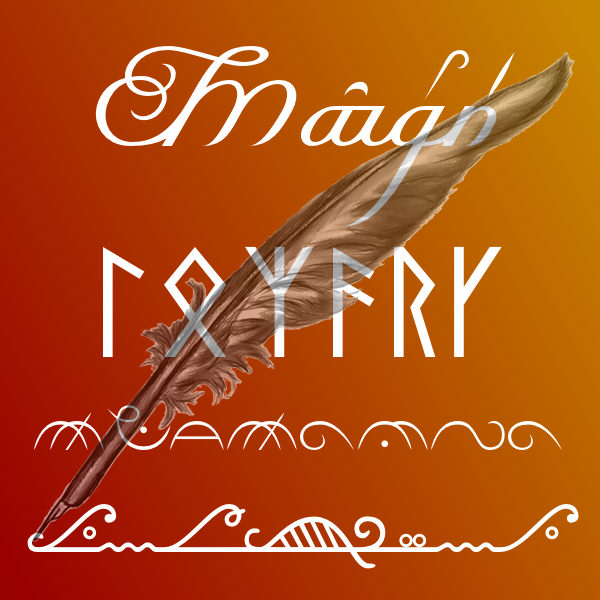Alternative Writing Systems
Quick Reference

Carogine, Erwendine, Lozark, and Vinglyph are all phonetic scripts, meaning that words are written according to how they sound, rather than according to traditional English spelling. Below is a chart comparing the 4 different scripts, with the International Phonetic Alphabet (IPA) symbol representing the pronunciation of each grapheme, and a sample word with the corresponding sound highlighted.
Consonants
| IPA | Carogine | Erwendine | Lozark | Vinglyph | Example |
|---|---|---|---|---|---|
| /p/ | p | p | p | p | pearl, pure |
| /b/ | b | b | b | b | ball, bear |
| /t/ | t | t | t | t1 | time, tree |
| /d/ | d | d | d | d1 | dawn, dog |
| /k/ | k | k | c, k | k | cat, kite |
| /g/ | g | g | g | g | gift, goat |
| /tʃ/ | c | c | C | c1 | church, cherry |
| /dʒ/ | j | j | j | j1 | just, gentle |
| /f/ | f | f | f | f1 | fox, falcon |
| /v/ | v | v | v | v1 | valley, vine |
| /θ/ | H | T | H | T1 | thorn, thunder |
| /ð/ | T | H | T | H1 | this, there |
| /s/ | s2 | s | s | s1 | sun, ceiling |
| /z/ | z2 | z | z | z1 | zoo, zephyr |
| /ʃ/ | S | S | S | S1 | shadow, ship |
| /ʒ/ | Z | Z | Z | Z1 | treasure, vision |
| /l/ | l | l | l | l | life, love |
| /r/ | r | r | r | r | rain, rest |
| /w/ | w3 | w | w | w | water, wind |
| /j/ | y4 | y | y | y | year, youth |
| /h/ | h | h | h | h | hill, hearth |
| /m/ | m5 | m | m | m1 | man, month |
| /n/ | n5 | n | n | n1 | night, nest |
| /ŋ/ | N5 | N | N | N1 | ingot, song |
Vowels and Diphthongs
| IPA | Carogine6 | Erwendine | Lozark | Vinglyph | Example |
|---|---|---|---|---|---|
| /ɑ/, /ɔ/ | A | A | A | A | father, all |
| /æ/ | a | a | a | a | apple, after |
| /aɪ/ | Y | Y | Y | Y | aisle, ice |
| /aʊ/ | W | W | AU | W | out, owl |
| /e/, /eɪ/ | E | E | E | E | able, eight |
| /ɛ/ | e | e | e | e | end, ever |
| /i/ | I | I | I | I | even, east |
| /ɪ/ | i | i | i | i | if, image |
| /o/, /oʊ/ | O | O | O | O | oath, open |
| /ə/, /ʌ/ | o | o | o | o | other, up |
| /ɔɪ/ | q | P | OI | P | oil, joy |
| /u/ | U | U | U | U | moon, lute |
| /ʊ/ | u | u | u | u | hook, should |
Vowel Combinations with R
| IPA | Carogine | Erwendine | Lozark | Vinglyph | Example |
|---|---|---|---|---|---|
| /ɑr/ | | Ar | Ar | B | are, star |
| /ɪər/ | | Ir | Ir | C | ear, iridescent |
| /ɔr/ | | Or | Or | D | or, soar |
| /ʊər/ | | Ur | Ur | F | moor, tour |
| /ær/ | | ar | ar | G | arrow, marriage |
| /ɛər/ | | er | er | J | air, errand, spare |
| /ɜr/ | | ir | ir | K | fir, earn, urgent |
Footnotes
1 In Vinglyph, the following consonants may be inverted: /t/, /d/, /tʃ/, /dʒ/, /f/, /v/, /θ/, /ð/, /s/, /z/, /ʃ/, /ʒ/, /m/, /n/, and /ŋ/. When two or more consonants from this set appear in succession, each alternate consonant is inverted, as in the word “against” M.
2 In Carogine, when an /s/ or /z/ follows a consonant, the /s/ or /z/ may be represented by a curl extending downward and to the right, as in “fox” or “first” .
3 In Carogine, a preceding /w/ sound may be represented by a tilde below, as in “where” or “question” . When preceded by a vowel, the w is written out, as in “awake” .
4 In Carogine, a preceding /j/ may be represented by a diaeresis below, as in “yes” or “year” . When preceded by a vowel, the y is written out, as in “reunite” .
5 In Carogine, a preceding /m/, /n/, or /ŋ/ sound may be represented by an underscore, as in “and” or “think” . The underscore may represent /n/ or /ŋ/ before any consonant, but it represents /m/ only preceding /b/ or /p/.
6 In Carogine, vowels are represented as diacritical marks placed above or below the consonant that follows, or over the vowel carrier . The diphthongs Y, W, and q each have their own carrier, and do not attach to a consonant.
To view a sample passage of text rendered in all four scripts, visit the Rosetta Poem.
Heaven



